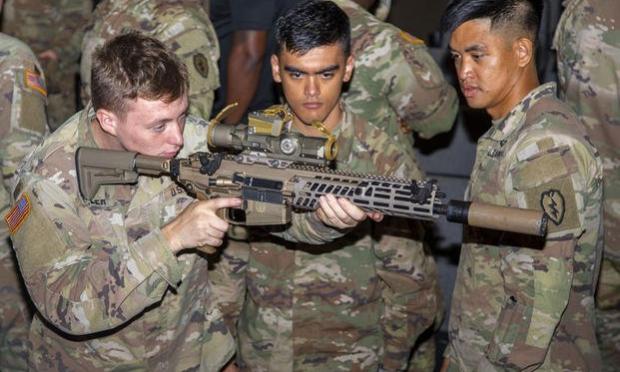With the Armed Forces moving ahead with prioritising armaments a news comes from the US where the ground army there has officially put the brand new Next Generation Squad Weapon rifles in its first unit, ending the service's decades-long attempt to replace the military's family of M4 and M16 rifles.
Future Army Command recently announced that Soldiers from the 1st Battalion, 506th Infantry Regiment, 101st Airborne Division, Fort Campbell, Kentucky, accepted delivery of the XM7 Next Generation Rifle and XM250 Next Generation Automatic Rifle prior to training in April.
Manufactured by Sig Sauer, the XM7 is intended to replace the M4 in close combat formations, while the XM250 will replace the M249 Squad Automatic Weapon or SAW. Both new rifles have a 6.8mm chambering to provide improved range and lethality against enemy armor.
The Next Generation Squad Weapon line also includes the XM157 Fire Control smart sight, manufactured by Vortex Optics, which incorporates advanced technologies such as a laser range finder, ballistic parameters calculator and digital display.
The retirement "is the culmination of a comprehensive and rigorous design, testing and feedback process, all of which were Soldier-led," said Col. Jason Bohannon, program manager of the Soldier Executive Office Program. "As a result, the Army is fulfilling its promise to deliver the highest quality, most capable small arms and small caliber ammunition to Soldiers."
Soldiers should be aware that the XM7 is significantly heavier than the M4
According to the Army's fiscal 2025 budget request, the service has a long-term plan to purchase 111,428 XM7 rifles, 13,334 XM250 automatic rifles and 124,749 XM157 fire control devices spanning through the 2030s.
The service has been pushing for a new family of infantry rifles since the mid-1980s, when it launched the Advanced Combat Rifle, or ACR, program to identify a replacement for the M16 family of assault rifles. The cancelled ACR program was followed by the XM29 Objective Individual Combat Weapon program in the 1990s and the XM8 assault rifle in the early 2000s, both of which were also abandoned.
The M4/M16 replacement effort gained new urgency during the war in Afghanistan, where U.S. soldiers found that the M16 family of rifles and 5, 56-millimeter standard issue -- designed for combat near Vietnam and suitable for urban warfare proved ineffective against Afghan insurgents engaged at longer ranges in the country's mountainous terrain, the Associated Press reported in 2010.
Sig Sauer finally closed the contract in 2022. Since then, the U.S. Army has conducted ongoing user testing on the rifles, putting them in extreme environments. In late March, days before the initial availability of the new weapons to the 1st Battalion, 506th Infantry Regiment was revealed, the service announced plans to build a 6.8 mm ammunition plant in Missouri to support the availability of the weapons throughout the force.
According to the Army, soldiers have spent more than 25,000 hours testing next-generation weapons from initial development through the field.
In Greece, the issue has essentially been frozen without, as well-informed military sources told Pentapostagma, any new type or upgrading of existing G-3s having been qualified, although soldiers with upgraded rifles of the type have appeared in recent exercises.
According to armament-related postings on the Ministry of National Defence's website, the last move related to the issue of the atomic rifle in the Greek Army was on 22 June last year when a presentation and demonstration was made by representatives of the company S.A.L.DYNE to personnel of the General Staff on laser sighting systems for rifles, from the company Rheinmetall, which it represents.







